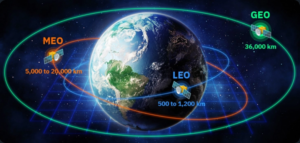How Satellite Constellations Are Shaping Our World
Intro
Satellite constellations comprise three distinct orbits: Geostationary Orbit (GEO), Middle Earth Orbit (MEO), and Low Earth Orbit (LEO). These satellite constellations have exerted a profound and transformative influence on the global economy. RTI International estimates that GPS has generated roughly $1.4 trillion in economic benefits in the U.S. since it was made available for civilian and commercial use in the 1980s.
Background
GEO constellations, positioned at a fixed point above the equator, offer continuous coverage over specific regions, catering to vital sectors such as communication and weather observation. MEO constellations strike a balance between coverage and latency, making them pivotal for applications demanding both global reach and reduced communication delays. MEO is the home to the world’s leading Global Navigation Satellite Systems. LEO constellations, orbiting closer to the Earth’s surface, deliver diverse services, from high-speed internet to communications, leveraging their proximity to deliver fast data transmission with very low latency. LEO is experiencing rapid growth led by Starlink’s plan to deploy thousands of satellites in this constellation orbit.
| Constellation | Positioning | Latency | # of Satellites (est.) |
|
GEO |
35,786 km |
Medium (~700 ms) |
580 |
|
MEO |
5,000 – 20,000 km |
Low (~150 ms) |
139 |
| LEO | 500 – 1,200 km | Very Low (~50 ms) |
>5,000 |
Geostationary Orbit (GEO)
GEO satellite constellations consist of satellites positioned at a fixed point above the Earth’s equator, approximately 35,786 kilometers (22,236 miles) in altitude. Due to their stationary position relative to the Earth’s rotation, GEO satellites remain above the same geographic area, providing continuous coverage of a specific region.
GEO constellations provide stable and predictable coverage, making them ideal for applications where constant connectivity and coverage of specific areas are paramount. These constellations are commonly used for communication, broadcasting, weather observation, and navigation services.
Key players include Intelsat (52 satellites), Eutelsat (36 satellites), Inmarsat (14 satellites), and Asiasat (7 satellites).
Middle Earth Orbit (MEO)
Middle Earth Orbit (MEO) satellite constellations are positioned from 5,000 to 20,000 kilometers above Earth’s surface. MEO satellites offer a balance between coverage area and latency, making them suitable for applications that require a mix of global reach and relatively lower communication delays.
Despite its lower number of satellites, MEO is home to the leading Global Navigation Satellite Systems (GNNS) including GPS, Galileo, BeiDou, and GLONASS. Refer to our blog, “Unlocking the Power of Global Navigation Satellite Systems via Interoperability,” for additional details.
Key players include SES (acquired O3b Networks in 2016), Spacelink (Electro Optic Systems), Mangata Networks, Viasat, Intelsat, and Methera Global.
Low Earth Orbit (LEO)
Low Earth Orbit (LEO) satellites satellite constellations are positioned from 500 to 1,200 kilometers above Earth’s surface. LEO satellites offer faster data transmission, reduced latency, and improved coverage compared to the other constellations.
Key LEO players include Iridium, Globalstar, Orbcomm, Starlink, OneWeb, Project Kuiper by Amazon, Telesat, and Planet Labs.
Positioning Universal Viewpoint
Positioning Universal continues to monitor advancements in satellite constellations technology, including new GPS III satellite technology being deployed in MEO and the rapid increase in the number of services being offered in LEO. Positioning Universal stays at the forefront of these advancements so we can further enhance the value provided to our customers.






